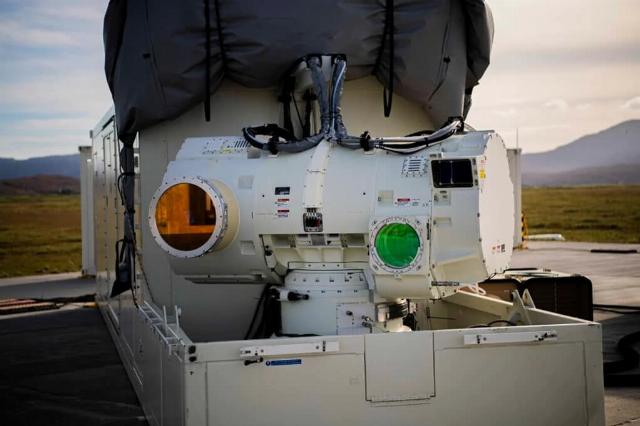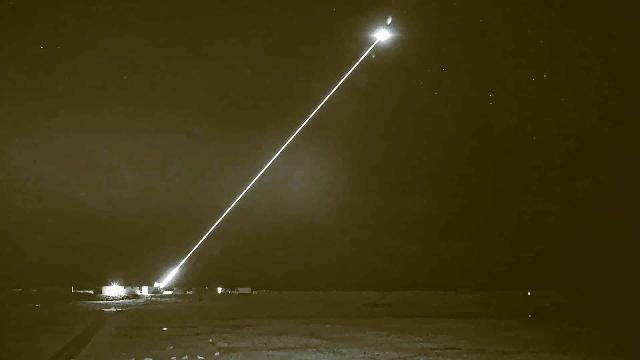The British Ministry of Defense has published a video from the tests of the classified DragonFire laser weapon, which took place in January 2024. This video is a mix of computer graphics and real footage from the landfill. To some extent, it allows us to draw conclusions about what specific purposes a laser installation can be used for.
In early 2017, a consortium led by the leading manufacturer of missile systems in Europe, MBDA, received an order for 30 million pounds from the British Ministry of Defense. According to him, MBDA was supposed to create a demonstrator of the first British long-range laser weapon system called DragonFire . Due to its demonstration status, this system will not be used in the British Army or Navy. The main task of such an installation is to show the "capabilities of the laser as a weapon" and provide data for the development of more advanced laser systems.
The project was widely publicized, but progress was slow at first, and there were rumors that it had stalled. However, work on DragonFire continued — in strict secrecy. The British Ministry of Defense has said almost nothing about the technical characteristics of this weapon.
In 2022, the Defense Department conducted successful tests of the DragonFire demonstrator at the Porton Down training ground in Wiltshire. Then there was shooting at fixed targets. In January 2024, another test of British laser weapons took place at the test site in the Hebrides in Scotland, this time shooting at moving air targets was carried out.
At the end of the January tests, the Ministry of Defense issued a reporting press release, but it did not say what specific targets DragonFire was working on. Some relevant media, citing their sources, reported that one of the targets was the British kamikaze drone Banshee Jet-80, equipped with two gas turbine engines with a thrust of 40 kilograms, allowing it to reach speeds of up to 200 meters per second and stay in the air for up to 45 minutes. In size, this drone is comparable to the Iranian attack drones used by the Houthis in the Red Sea to attack civilian and military vessels.
Then experts suggested that one of the main tasks of the British laser weapon is the fight against drones at sea, which means, with a high degree of probability, it can be installed on warships. However, before adopting DragonFire technology into service, it needs to be adapted to specific needs. Now the demonstrator consists of commercial components (COST), in order for it to turn into a full-fledged weapon, its components will need to be replaced with much more reliable analogues that meet military standards (MOTS).
Just the other day, the British military showed footage of the last January DragonFire tests. The video still does not give a complete picture of the capabilities of the system, nevertheless it shows what kind of weapons the installation can be used against.
The footage shows the control center, the operation of the laser on the stand and the defeat of the target at the landfill in an open area. A photo of an artillery mine struck by a laser is presented separately, although it is not specified exactly how it was struck — in the air or on a stationary stand.
Video from the tests of the DragonFire laser demonstrator, which took place in January 2024
In addition to real footage from the tests, there is a lot of animation in the video. In particular, the work of DragonFire installed on the British Navy Type 26 frigate ("Global Warship") is shown. In the animation, laser weapons strike fast coastal attack boats and drones.
In addition, representatives of the Ministry of Defense confirmed the guesses of experts that during the tests at the test site in Scotland, the Banshee Jet-80 drone was indeed among the air targets.
Dragonfire is a purely British development, the joint brainchild of missile system manufacturer MBDA (Matra BAE Dynamics Alenia) and defense company Dstl (Defense Science and Technology Laboratory). The main part of the installation is a combat "tower", which is used to generate a laser beam with a QinetiQ emitter.
The estimated laser power is 50 kilowatts. However, the system was specifically designed with the ability to increase or decrease power in order to provide a flexible basis for various types of laser weapons of the future.
An artillery mine struck by a laser
Image source: Ministry of Defence UK
According to the British Ministry of Defense, dozens of optical fibers are used in the laser installation as a pumping medium, which are "reduced" into a single beam using a special system developed in Britain. However, most of the technical details of the project remain classified.
The technology of electron-optical identification of targets and their tracking has been implemented in the tower of the "Fire-Breathing Dragon". An image of the "captured" target is displayed on a special screen, after which its parameters, options for tracking and destruction are specified.
The range of the Dragonfire is also classified. The weapon has the accuracy to hit a one pound sterling coin (23.03-23.43 millimeters in diameter) from a kilometer away. According to the Ministry of Defense, in 10 seconds of operation, DragonFire consumes the same amount of energy as a conventional household heater for an hour. If this is the case, then the peak laser power is significantly more than 50 kilowatts, which it was estimated earlier (the power of household heaters is normally above one kilowatt, and 10 seconds is 1/360 of an hour).
As for the cost of one "shot", it is less than 10 pounds (almost 13 US dollars). Each such "shot" of the laser flies at a speed close to the speed of light.

The "tower" of a combat laser installation
Image Source: Crown Copyright
Successful tests of the Dragonfire demonstrator have shown that the British technology of the long-range directed energy laser weapon system has great potential. It is not yet known exactly when installations based on such systems will enter the arms of the United Kingdom, however, according to experts, the Navy will be the first to use them.
It is believed that lasers will become an inexpensive alternative to air defense missiles. With the help of such weapons, it will be possible to shoot down the same drones.
The leading military powers have been developing laser weapons since the middle of the last century. Today, Israel, China, Russia and the United States have it. For example, in 2017, the United States successfully tested the experimental 30-kilowatt XN-1 LaWS laser complex, and more recently, the AN/SEQ—4 ODIN (Optical Dazzling Interdictor, Navy) optical "blinding" laser system for unmanned aerial vehicles.
In 2020, the US military successfully tested a 150 kilowatt LWSD laser weapon system demonstrator. In 2022, a combat laser with a built-in blinding function and a HELIOS surveillance function was installed on the American destroyer USS Preeble , its power is 60 kilowatts. The Pentagon is currently working on creating a 300 kilowatt high-energy laser ( HELCAP ) to defeat anti-ship missiles.

